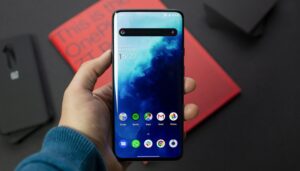Panel types
In recent years, smartphone displays have developed far more acronyms than ever before with each different one featuring a different kind of technology. AMOLED, LCD, LED, IPS, TFT, PLS, LTPS, LTPO…the list continues to grow.
As if the different available technologies weren’t enough, component and smartphone manufacturers adopt more and more glorified names like “Super Retina XDR” and “Dynamic AMOLED”, which ends up increasing the potential for confusion among consumers. So let’s take a look at some of these terms used in smartphone specification sheets and decipher them.
There are many display types used in smartphones: LCD, OLED, AMOLED, Super AMOLED, TFT, IPS and a few others that are less frequently found on smartphones nowadays, like TFT-LCD. One of the most frequently found on mid-to-high range phones now is IPS-LCD. But what do these all mean?
In short, there are two kinds of technologies available in the market for smartphone displays: LCD and OLED. Each of them has several variations and generations, which gives rise to more acronyms, similar to televisions and their different ranges such as LED, QLED, miniLED – which are all actually variations of LCD technology.
2021 03 18 Samsung OLED
Flexible displays and microLED technology are some of the areas manufacturers dive into / © Samsung Display
What is an LCD display?
LCD means Liquid Crystal Display, and its name refers to the array of liquid crystals illuminated by a backlight, and their ubiquity and relatively low-cost makes them a popular choice for smartphones and many other devices.
LCDs also tend to perform quite well in direct sunlight, as the entire display is illuminated from behind, but does suffer from potentially less accurate colour representation than displays that don’t require a backlight.
Within smartphones, you have both TFT and IPS displays. TFT stands for Thin Film Transistor, an advanced version of LCD that uses an active matrix (like the AM in AMOLED). Active matrix means that each pixel is attached to a transistor and capacitor individually.
The main advantage of TFT is its relatively low production cost and increased contrast when compared to traditional LCDs. The disadvantage of TFT LCDs is higher energy demands than some other LCDs, less impressive viewing angles and colour reproduction. It’s for these reasons, and falling costs of alternative options, that TFTs are not commonly used in smartphones anymore.
IPS displays
IPS technology (In-Plane Switching) solves the problem that first generation of LCD displays experience, which adopt the TN (Twisted Nematic) technique: where colour distortion occurs when you view the display from the side – an effect that continues to crop up on cheaper smartphones and tablets.
In IPS panels, the liquid crystals are aligned to the display, resulting in superior viewing angles – usually listed at 178º on TVs, which is another characteristic of IPS displays. Another characteristic of IPS displays in relation to other LCD technologies is superior colour reproduction, which explains the use of such panels in monitors that are meant for image editing jobs.
2021 03 17 LG display IPS explainer
In smartphones, the advantage of having IPS is the balance between cost and colour reproduction / © LG Display
PLS LCD displays
The PLS (Plane to Line Switching) standard uses an acronym that is very similar to that of IPS, and is it any wonder that its basic operation is also similar in nature? The technology, developed by Samsung Display, has the same characteristics as IPS displays – good colour reproduction and viewing angles, but a lower contrast level compared to OLED and LCD/VA displays.
According to Samsung Display, PLS panels have a lower production cost, higher brightness rates, and even superior viewing angles when compared to their rival, LG Display’s IPS panels. Ultimately, whether a PLS or IPS panel is used, it boils down to the choice of the component supplier.
Is the display LED or LCD?
This is a very common question after “LED” TVs launched, with the short answer simply being LCD. The technology used in a LED display is liquid crystal, the difference being LEDs generating the backlight.
LEDs have the advantage of consuming very little power – which explains the emphasis given by marketing departments in highlighting the term in TVs, but not so much when it comes to smartphones with their reduced display size. On the other hand, backlight operation makes it difficult for LCD/LED displays to offer a level of contrast that is competitive with OLED displays since the lighting control is not performed by each individual pixel, but by regions on the display.
NextPit Xiaomi Mi 10T Pro front camera
The Xiaomi Mi 10T Pro has one of the most advanced LCD/LED screens of 2021 / © NextPit
AMOLED displays
AMOLED stands for Active Matrix Organic Light-Emitting Diode. While this may sound complicated it actually isn’t. We already encountered the active matrix in TFT LCD technology, and OLED is simply a term for another thin-film display technology.
OLED is an organic material that, like the name implies, emits light when a current is passed through it. As opposed to LCD panels, which are back-lit, OLED displays are ‘always off’ unless the individual pixels are electrified.
This means that OLED displays have much purer blacks and consume less energy when black or darker colours are displayed on-screen. However, lighter-coloured themes on AMOLED screens use considerably more power than an LCD using the same theme. OLED screens are also more expensive to produce than LCD.
Because the black pixels are ‘off’ in an OLED display, the contrast ratios are also higher compared to LCD screens. AMOLED displays have a very fast refresh rate too, but on the downside are not quite as visible in direct sunlight as backlit LCDs. Screen burn-in and diode degradation (because they are organic) are other factors to consider.
On the positive side, AMOLED screens can be made thinner than LCDs (because they don’t require a backlit layer) and they can also be made flexible.
AndroidPIT Samsung Galaxy S9 S9plus 0647
Samsung’s Galaxy S range currently uses Super AMOLED displays. / © NextPit
What’s the difference between OLED, AMOLED and Super AMOLED?
OLED stands for Organic Light Emitting Diode. An OLED display is comprised of thin sheets of electroluminescent material, the main benefit of which is they produce their own light, and so don’t require a backlight, cutting down on energy requirements. OLED displays are more commonly referred to as AMOLED displays when used on smartphones or TVs.
As we’ve already covered, the AM part of AMOLED stands for Active Matrix, which is different from a Passive Matrix OLED (P-OLED), though these are less common in smartphones.
Super AMOLED is the name given by Samsung to its displays that used to only be found in high-end models but have now trickled down to more modestly specced devices. Like IPS LCDs, Super AMOLED improves upon the basic AMOLED premise by integrating the touch response layer into the display itself, rather than as an extra layer on top.
As a result, Super AMOLED displays handle sunlight better than AMOLED displays and also require less power. As the name implies, Super AMOLED is simply a better version of AMOLED. It’s not all just marketing bluster either: Samsung’s displays are regularly reviewed as some of the best around.
The latest evolution of the technology has been christened “Dynamic AMOLED”. Samsung didn’t go into detail about what the term means, but highlighted that panels with such identification include HDR10+ certification that supports a wider range of contrast and colours, as well as blue light reduction for improved visual comfort.
In the same vein, the term “Fluid AMOLED” used by OnePlus on its most advanced devices basically highlights the high refresh rates employed, which results in more fluid animations on the screen.
Foldable and rollable displays
Another advantage of OLED displays is this: by doing away with an illumination layer, the component can not only be thinner but is also more flexible. This feature already sees action in smartphones with bendable displays and is also employed in conceptual devices with a rollable display.
AndroidPIT huawei mate xs on the edge
Salvador Dalí would be proud / © NextPit
The technology debuted with the obscure Royole FlexPai, equipped with an OLED panel supplied by China’s BOE, and was then used in the Huawei Mate X (pictured above) and the Motorola Razr (2019), where both also sport BOE’s panel – and the Galaxy Flip and Fold lines, using the component supplied by Samsung Display.
Retina, Super Retina XDR: what are they?
Speaking of pixel density, this was one of Apple’s highlights back in 2010 during the launch of the iPhone 4. The company christened the LCD screen (LED, TFT, and IPS) used in the smartphone as “Retina Display”, thanks to the high resolution of the panel used (960 by 640 pixels back then) in its 3.5-inch display.
The name coined by Apple’s marketing department is applied to screens which, according to the company, the human eye is unable to discern the individual pixels from a normal viewing distance. In the case of iPhones, the term was applied to displays with a pixel density that is greater than 300 ppi (dots per inch).
Since then, other manufacturers have followed suit, adopting panels with increasingly higher resolutions. While the iPhone 12 mini offers 476 dpi, while models like Sony Xperia 1 boast a whopping 643 dpi.
Will you ever need 4K resolution on your smartphone?
To differentiate itself, Apple launched the term “Super Retina”, which basically defines the OLED screens used on the iPhone X onwards, or the high contrast rates and colour accuracy that Galaxy S smartphone owners enjoy, and was even spotted in even some earlier Nokias.
AndroidPIT apple iphone 11 pro front
Apple highlights the high contrast and brightness rates of the OLED screen in the iPhone 11 Pro / © NextPit
With the iPhone 11 Pro, another term was introduced to the equation: “Super Retina XDR”. Still using an OLED panel (that is supplied by Samsung Display or LG Display), the smartphone brings even higher specs in terms of contrast – with a 2,000,000:1 ratio and brightness level of 1,200 nits, which have been specially optimized for displaying content in HDR format.
As a kind of consolation prize for iPhone XR and iPhone 11 buyers, who continued relying on LCD panels, Apple classified the display used in the smartphones with a new term, “Liquid Retina”. This was later applied also to the iPad Pro and iPad Air models, with the name defining screens that boast a high range and colour accuracy, at least based on the company’s standards.
Nits and brightness levels
Nit, or candela per square meter in the international system (cd/m²), is a unit of measurement of luminance, i.e. the intensity of light emitted. In the case of smartphone screens and monitors in general, such a value defines just how bright the display is – the higher the value, the more intense the light emitted by the screen.
Refresh rates: what do 60Hz, 90Hz, and 120Hz mean?
Popularized in 2019 and 2020 by high-end and even some mid-range smartphones, the terms “120 Hz”, “90 Hz” and others with a similar measurement in Hertz represent the refresh rate of the panel, be it LCD or OLED. The higher the value, the more frames per second are displayed on the screen.
2021 03 18 refresh rate
The higher the number, the smoother the animation is / © Samsung Electronics
The result is smoother animations on the phone, both during regular use and in games, compared to screens that have a 60 Hz refresh rate which remains the standard rate in the market when it comes to displays.
Originally touted to be a “gimmick” in 2017, with the launch of the Razer Phone, the feature gained more and more momentum in due time, even with a corresponding decrease in battery life. In order to make the most of this feature, manufacturers began to adopt screens with variable refresh rates, which can be adjusted according to the content displayed – which is 24 fps in most movies, 30 or 60 fps in home video recordings, and so forth.
The same unit of measurement is used for the sampling rate. Although similar, the value here represents the number of times per second the screen is able to register touches. The higher the sample rate, the faster the smartphone registers such touches, which results in a faster response time.
Myth or fact: Does fast charging damage your smartphone battery?
TFT, LTPS, LTPO, IGZO
To further muddy the alphabet soup that we’ve come across, you will also run into other less common terms that are often highlighted in promotional materials for smartphones.
TFT(Thin Film Transistor) – a type of LCD display that adopts a thin semiconductor layer deposited on the panel, which allows for active control of the colour intensity in each pixel, featuring a similar concept as that of active-matrix (AM) used in AMOLED displays. It is used in TN, IPS/PLS, VA/PVA/MVA panels, etc.
LTPS (Low Temperature PolySilicon) – a variation of the TFT that offers higher resolutions and lower power consumption compared to traditional TFT screens, based on a-Si (amorphous silicon) technology.
IGZO (Indium Gallium Zinc Oxide) – a semiconductor material used in TFT films, which also allows higher resolutions and lower power consumption, and sees action in different types of LCD screens (TN, IPS, VA) and OLED displays
LTPO( Low Temperature Polycrystaline Oxide) – a technology developed by Apple that can be used in both OLED and LCD displays, as it combines LTPS and IGZO techniques. The result? Lower power consumption. It has been used in the Apple Watch 4 and the Galaxy S21 Ultra.
How to extend the battery life of your smartphone
Displays of the future: microLED
Among televisions, the long-standing featured technology has always been miniLED – which consists of increasing the number of lighting zones in the backlight while still using an LCD panel. There are whispers going around that smartphones and smartwatches will be looking at incorporating microLED technology in their devices soon, with it being radically different from LCD/LED displays as it sports similar image characteristics to that of OLEDs.
A microLED display has one light-emitting diode for each subpixel of the screen – usually a set of red, green, and blue diodes for each dot. Chances are it will use a kind of inorganic material such as gallium nitride (GaN).
By adopting a self-emitting light technology, microLED displays do not require the use of a backlight, with each pixel being “turned off” individually. The result is impressive: your eyes see the same level of contrast as OLED displays, without suffering from the risk of image retention or burn-in of organic diodes.
Another advantage of microLED technology is the potential to display images with higher brightness levels while benefitting from lower power consumption, combining the strengths of both OLED and LCD panels.
Samsung MicroLED DL1
Cost of technology and miniaturization of diodes remain as the main challenges for microLED / © Samsung Electronics
On the other hand, the use of multiple diodes for each pixel poses a challenge in terms of component miniaturization. For example, a Full HD resolution has just over two million pixels (1,920 x 1,080 dots), which requires 6 million microscopic LEDs using a traditional RGB (red, green, and blue) structure.
This is one of the reasons that explain the adoption of such technology to date remains rather limited in scope. You will see them mainly in large screens of 75 to 150 inches only, which enable 4K resolution (3,840 x 2,160 resolution, which is close to 8.3 million pixels or 24.8 million RGB subpixels). This is a huge number of pixels to look at!
Another thing to be wary of is the price – at 170 million Korean won (about US$150,330 after conversion), that is certainly a lot of money to cough up for a 110-inch display.
Pros and cons of having an 18:9 screen ratio
Which is better: LCD/LED or AMOLED?
Each technology has its own advantages and disadvantages but in recent years, OLED screens have gained prominence, especially with the adoption of the component in high-end flagship smartphones. It gained an even greater degree of popularity after the launch of the iPhone X, which cemented the position of OLED panels in the premium segment.
As previously stated, OLED/AMOLED screens have the advantage of a varied contrast level, resulting from individual brightness control for the pixels. Another result of this is the more realistic reproduction of black, as well as low power consumption when the screen shows off dark images – which has also helped to popularize dark modes on smartphones.
On the downside, OLED screens have a higher manufacturing cost, as well as a smaller number of suppliers – dominated by South Korea’s Samsung Display and LG Display, with China’s BOE in third place and a few other Chinese manufacturers filling up the remaining demand when compared to LCD panels.
OLED Manchas
OLED displays can experience burn-in if you are not careful / © NextPit
In addition, the organic diodes that give OLED screens their name can lose their ability to change their properties over time, and this happens when the same image is displayed for a long period of time. This problem is known as “burn-in”, tends to manifest itself when higher brightness settings are applied for long periods of time.
While that is a very real possibility, it is not something that affects most users, who often confuse burn-in with a similar problem – image retention, which is temporary and usually resolves itself after a few minutes.
How to fix screen burn-in or image retention on your AMOLED display
In the case of LCD displays, the main advantage lies in the low manufacturing cost, with dozens of players in the market offering competitive pricing and a high production volume. Some brands have taken advantage of this feature to prioritize certain features – such as a higher refresh rate – instead of adopting an OLED panel, such as the Xiaomi Mi 10T.
It is also worth remembering that, as with almost all types of components, there are AMOLED and LCD screens with different levels of quality and features, which can be combined in various ways to achieve a certain price point. This is a lengthy discussion, which has even been the subject of a heated debate between my colleagues, Ben and Rahul.
Source: https://www.nextpit.com/smartphone-displays-explained
- https://www.nextpit.com/
- Smartphone
- United States









